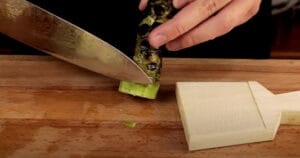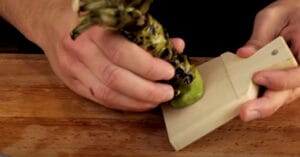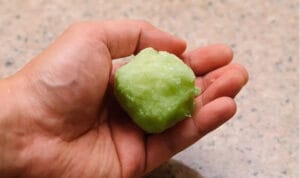Hi, James Anderson and Yukiko here, your culinary guide at Food And Meal. Today, I’m happy to share with you a topic that’s close to my heart and palate – homemade wasabi. Yes, you heard it right! We’re diving into the world of this fiery green paste that has the power to transform any dish from ordinary to extraordinary.
As a chef, I’ve always been fascinated by the unique flavor profile of wasabi. It’s not just about the heat; it’s about the subtle, earthy undertones that can add depth to a variety of dishes. From sushi to steak, wasabi has a way of elevating the taste experience to a whole new level.
But let’s be honest, most of us are familiar with the store-bought version, which often contains European horseradish and green food coloring. While it does the job, nothing beats the authentic taste of homemade wasabi, made from the Japanese horseradish plant, Wasabia japonica. The difference in flavor is like night and day!
In this post, I’ll be sharing some of my favorite recipes that incorporate homemade wasabi. These recipes are not only delicious but also a fun way to experiment with this versatile ingredient. Whether you’re a seasoned cook or a beginner in the kitchen, I promise these recipes will bring a dash of adventure to your cooking routine.
So, are you ready to turn up the heat in your kitchen? Let’s dive into the exciting world of homemade wasabi!
Best Wasabi Recipes
If you’re wondering how to make wasabi easily, this recipe is perfect for you. Preparation is very critical. It’s important to make sure that the wasabi recipe you use is fresh and made from the right ingredients. It should be stored in an airtight container, preferably in a cool place. In addition to that, the wasabi paste can also be molded. Once it’s ready to use, place it on a dish.
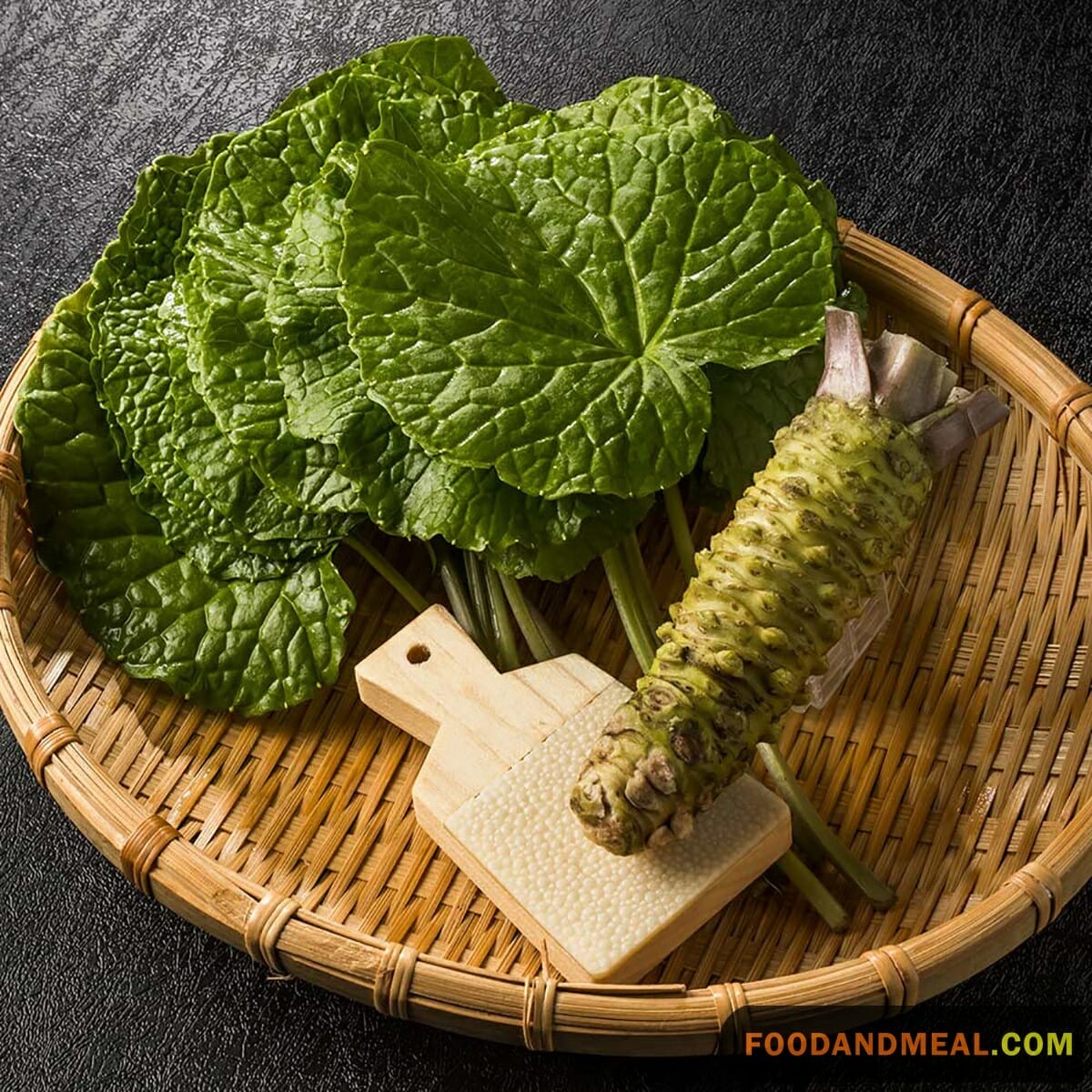
Wasabi ingredients – What will you need ?
To prepare fresh wasabi, one would need the following:
- Wasabia japonica rhizome: This is the main component of wasabi. It is often difficult to find outside Japan as it requires specific growing conditions, but it can sometimes be sourced from specialty stores or online suppliers.
- Grater: A traditional sharkskin grater, known as an oroshigane, is used to grate the wasabi rhizome into a fine paste. However, a fine metal grater can also be used as a substitute.
- Water: A small amount of water may be mixed with the grated wasabi to adjust its consistency.
For those who do not have access to fresh Wasabia japonica, a common alternative is a wasabi paste made from a combination of horseradish, mustard, starch, and green food coloring. This is widely available in tubes or as a powder that can be reconstituted with water. In our recipe, the wasabi ingredients:
- Horseradish
- Mustard powder
- Soysauce
- Vinegas
- Anchovy
It’s important to note that the flavor profile and potency of fresh Wasabi japonica differ significantly from the horseradish-based substitutes. Fresh wasabi has a more delicate, herbal, and nuanced taste compared to the sharper and more robust flavor of horseradish.

Wasabi
Equipment
Ingredients
From the rhizome
- Wasabi root
Instructions
From the fresh rhizome
- Wash the wasabi rhizome and let it air dry.

- Peel about ⅓ inch around the end.

- Grate using a fine grater, or special wasabi sharkskin grater, enough for 1 serving or more.

- Shape the resulting paste into a ball and let it stand for about 10 minutes for the flavor to develop.

- Wrap any leftover in a damp paper towel and then with plastic wrap.
- Note: Wasabi is pungent, so be careful not to get it in your eyes. Also, the flavor quickly deteriorates.
To store wasabi root
- Wrap it in muslin cloth, leaving the cut end exposed.
- Immerse the cut end in a little water and refrigerate. Change the water every 3 days. Wasabi will keep this way for about a month.
To make imitation wasabi
- Combine ingredients thoroughly and adjust the flavor accordingly. Store in an airtight jar and refrigerate.
- A regular condiment for sushi.
Video
Notes
- Wasabi's intensity can vary based on its preparation. Always taste and adjust according to your preference. Remember, it's easier to add more than to take away.
- While wasabi is traditionally paired with sushi, its versatile nature allows it to be used in various dishes. Be adventurous and let your culinary imagination soar.
- For those new to wasabi, the heat might be intense initially but quickly mellows. Don't be put off by the initial punch; the nuanced flavors are worth the journey.
Nutrition
© Food And Meal
This website provides approximate nutrition information for convenience and as a courtesy only. Nutrition data is gathered primarily from the Spoonacular Database, whenever available, or otherwise other online calculators.
Alternative Method: Making Wasabi with a Food Processor
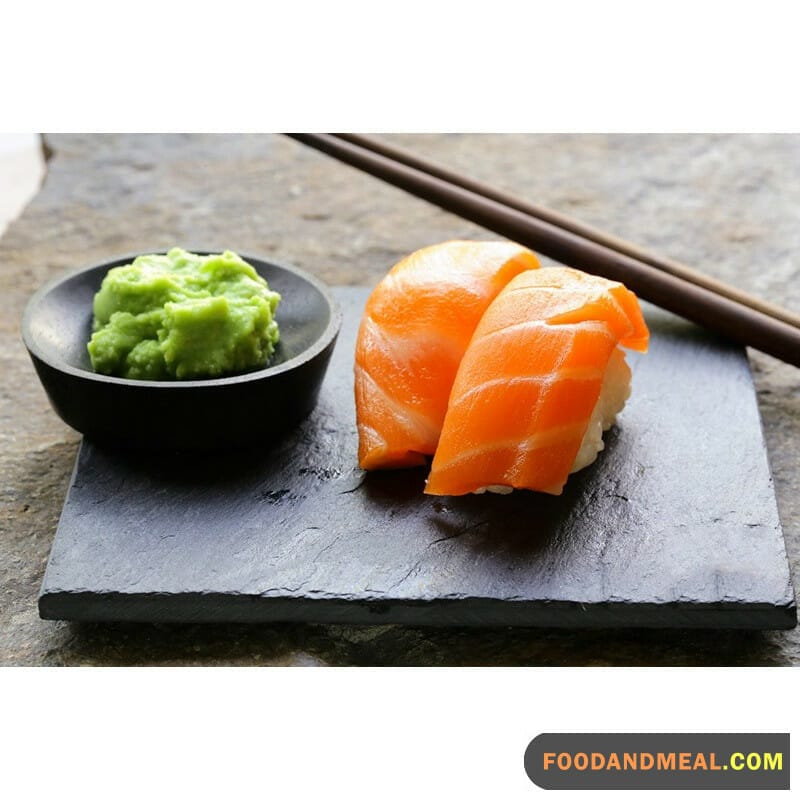
Wasabi Ingredients:
- 1 fresh wasabi rhizome (about 2-3 inches)
- 1 teaspoon of water
- 1/4 teaspoon of sugar
- A pinch of salt
Instructions:
- Prep the Wasabi: Begin by peeling the fresh wasabi rhizome using a knife or a vegetable peeler to remove any outer skin. Cut it into small, manageable pieces.
- Add Sugar and Salt: In a small bowl, combine the sugar and a pinch of salt. Sprinkle this mixture over the pieces of wasabi and let them sit for about 5 minutes. This will help release the flavors.
- Blending Process: Place the wasabi pieces into your food processor. Add about a teaspoon of water to aid in the blending process.
- Pulse and Scrape: Pulse the food processor a few times, then stop to scrape down the sides. Repeat this process until the wasabi is finely grated. Be cautious not to over-process, as this can heat the wasabi and reduce its spiciness.
- Taste and Adjust: Taste your homemade wasabi and adjust the spiciness to your liking by adding more grated wasabi or a pinch of sugar if needed.
- Transfer and Store: Transfer your freshly made wasabi paste to an airtight container. Store it in the refrigerator for up to a week.
Tips for making Wasabi
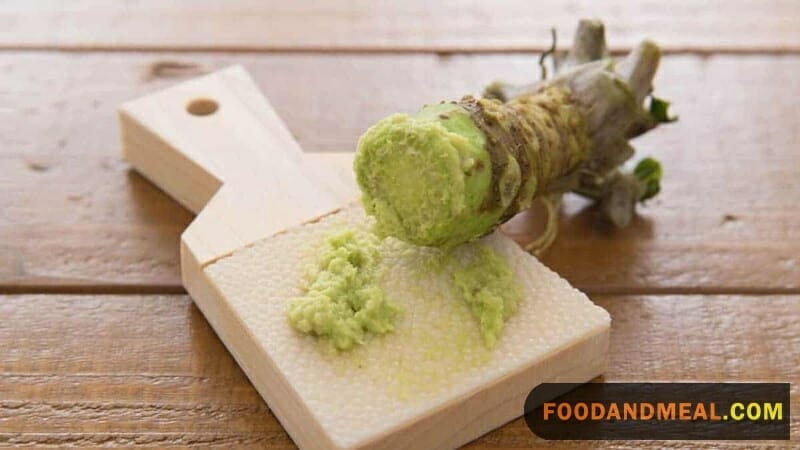
Cooking Tips
- Choosing the Right Rhizome: Select a fresh wasabi rhizome that feels firm and heavy. Avoid any that appear shriveled or dry. The best rhizomes are often vibrant green and have a clean, earthy aroma.
- Peeling and Prepping: When peeling the rhizome, use a knife or vegetable peeler to remove the outer skin. Cut it into small pieces for easy blending or grating.
- Grating or Blending: Whether you choose to grate by hand or use a food processor, be cautious not to over-process. Overheating can reduce the spiciness of wasabi. Aim for a fine, paste-like consistency.
- Sugar and Salt Trick: Enhance the flavor by combining the wasabi pieces with a pinch of sugar and salt for a few minutes before blending or grating. This brings out the natural heat and aroma.
- Maintain Freshness: To maintain the freshness and vibrant green color of your homemade wasabi, store it in an airtight container in the refrigerator. Keep it away from air and light exposure.
Serving Suggestions

- Fish Skewers on Farmer’s Salad: Add a dollop of homemade wasabi on the side for an extra kick. The heat from the wasabi will complement the freshness of the salad and the grilled fish.
- Grilled Sea Bream: Serve with a wasabi-infused soy sauce. The wasabi will add a spicy depth to the umami-rich soy sauce, enhancing the flavor of the grilled sea bream.
- BBQ Prawns in Honey Mustard Sauce: Try adding a touch of wasabi to your honey mustard sauce for a surprising twist. The wasabi will cut through the sweetness of the honey and add a complex flavor profile.
- Sushi Balls and Nigiri Sushi: These are classic dishes where wasabi is traditionally used. Serve with a side of homemade wasabi paste for guests to use at their discretion.
- Japanese Green Tea Rice: Mix a small amount of wasabi into the rice before serving. The wasabi will give a subtle heat that pairs well with the delicate flavor of the green tea.
- Wasabi Style Mashed Potatoes: Incorporate homemade wasabi directly into your mashed potatoes for a spicy, Japanese-inspired twist on this classic side dish.
- Tuna casserole and Tuna Steak with Green Bean Salad: Tuna and wasabi are a match made in heaven. Serve these dishes with a wasabi mayo or a wasabi-infused soy sauce on the side.
- Teriyaki Chicken Casserole and Teriyaki Mushroom: Add a hint of wasabi to your teriyaki sauce for an extra layer of flavor. The spiciness of the wasabi will balance out the sweetness of the teriyaki.
- Japanese Porridge Bowl: A small amount of wasabi can add a nice kick to this comforting dish. Mix it into the porridge or serve on the side.
- Japanese Mushroom Noodle Soup: Add a swirl of wasabi paste into the soup just before serving. The heat from the wasabi will add a pleasant contrast to the earthy flavors of the mushroom and noodles.
Frequently Asked Questions About Homemade Wasabi

- How long does homemade wasabi stay fresh?Homemade wasabi can stay fresh for up to one week when stored properly. Keep it in an airtight container in the refrigerator. Be sure to minimize air and light exposure to maintain its vibrant green color and flavor.
- Can I adjust the spiciness of homemade wasabi? Yes, you can adjust the spiciness to your liking. If you find it too mild, add more freshly grated wasabi. If it’s too intense, you can temper it with a pinch of sugar.
- Is homemade wasabi milder than store-bought wasabi paste? Homemade wasabi can be milder or spicier, depending on your preferences. Since it’s made fresh, you have control over its spiciness. Store-bought wasabi paste can vary in intensity.
- Can I freeze homemade wasabi for long-term storage? Freezing can affect the texture and flavor of homemade wasabi, so it’s not recommended. It’s best enjoyed fresh within the week of making.
- Are there any health benefits to consuming homemade wasabi? Yes, wasabi is known for its potential health benefits. It contains compounds that may have antibacterial properties and antioxidants. Additionally, it can help clear your sinuses and aid digestion.
- Want to elevate your homemade wasabi experience even further? Consider preparing your sushi or sashimi at home with rice from the best Japanese rice cooker. These cookers ensure you get perfectly cooked rice every time, enhancing the flavors of your meal and making it feel like an authentic Japanese dining experience. Do your research and find the best Japanese rice cooker that suits your needs. After all, great sushi starts with great rice.
Conclution
And there you have it, We’ve journeyed together through the vibrant world of homemade wasabi, exploring its unique flavor and versatility in the kitchen. I hope that this exploration has not only expanded your culinary horizons but also sparked a newfound appreciation for this extraordinary ingredient.
As we’ve discovered, homemade wasabi is more than just a fiery condiment for sushi. It’s a versatile ingredient that can add depth and complexity to a wide range of dishes. From salad dressings to desserts, the possibilities are truly endless when you start experimenting with wasabi in your own kitchen.
I must admit, there’s something incredibly satisfying about making your own wasabi from scratch. The process is almost therapeutic, and the end result is a fresh, potent paste that far surpasses any store-bought version. It’s a labor of love, but one that is well worth the effort.
In closing, I encourage you all to embrace the heat and dive into the world of homemade wasabi. Whether you’re a seasoned chef or a home cook, there’s always room for a little adventure in the kitchen. And who knows? You might just discover your new favorite ingredient along the way.
Thank you for joining me on this culinary journey. Until next time, keep exploring, keep experimenting, and most importantly, keep cooking!





